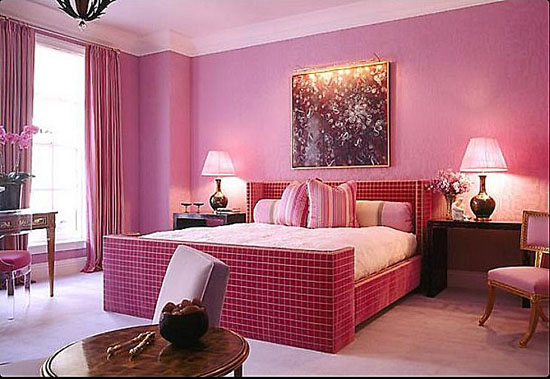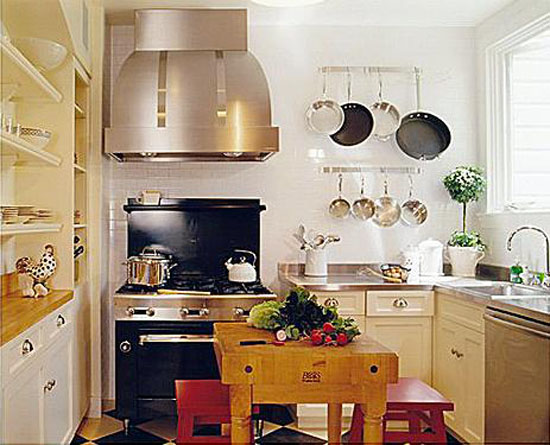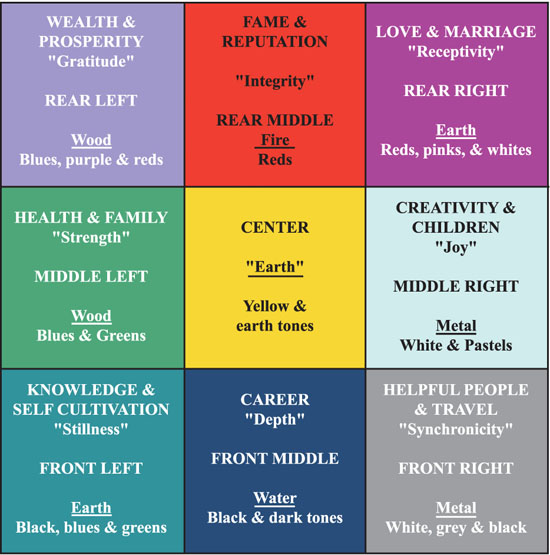 |
|
|
Pink creates romance in a bedroom. Adding brown will tone down and neutralize the pink for wider appeal. Photos provided
|
|
|
|
|
|
Color can be transformative, especially in feng shui. The principles of feng shui are founded on traditional Chinese medicine, based on the dynamic opposites of yin and yang - together with the five elements: water, wood, fire, earth and metal - as well as form, landscape, space orientation and time. Feng shui is about creating a natural equilibrium while promoting health, harmony, stability and prosperity. Activating an area of your home located on the Bagua map with color can activate the corresponding area of your life. In feng shui we like to apply color to activate a specific element that governs any of the nine Bagua areas and each of the five elements.
 Color and hue or intensity selection can be downright daunting for many, but it doesn't have to be. Today there are endless inspirations, oodles of samples to try out before you commit to a color for an entire room. Start with the rooms where you spend the most time. Create a more romantic master bedroom with a pinky brown or transform your kitchen with feng shui favored whites that show off colorful food best.
Color and hue or intensity selection can be downright daunting for many, but it doesn't have to be. Today there are endless inspirations, oodles of samples to try out before you commit to a color for an entire room. Start with the rooms where you spend the most time. Create a more romantic master bedroom with a pinky brown or transform your kitchen with feng shui favored whites that show off colorful food best.
 If you overlay the Feng Shui Bagua (see diagram on page D8) over the space from the front door wall, you can easily see what rooms in the home are located in the areas of "wealth" (far left, wood), "relationships" (far right, earth) or "health" (center, earth). Take another look at the Feng Shui Bagua to see which colors are associated with those areas and identify which of the five elements is activated when applying a color to that area of your home.
If you overlay the Feng Shui Bagua (see diagram on page D8) over the space from the front door wall, you can easily see what rooms in the home are located in the areas of "wealth" (far left, wood), "relationships" (far right, earth) or "health" (center, earth). Take another look at the Feng Shui Bagua to see which colors are associated with those areas and identify which of the five elements is activated when applying a color to that area of your home.
 Picking specific colors based on what you do in a particular room needs special consideration. It would be inauspicious, for example, to incorporate "active" or yang colors - red, orange, bright yellow - in a bedroom where calmer, more yin colors work best for sleeping. Children's rooms often bloom with shades of soft green that signify growth and development.
Picking specific colors based on what you do in a particular room needs special consideration. It would be inauspicious, for example, to incorporate "active" or yang colors - red, orange, bright yellow - in a bedroom where calmer, more yin colors work best for sleeping. Children's rooms often bloom with shades of soft green that signify growth and development.
 It's also critical to choose environmentally-friendly paint. Remember to use a base coat and two coats of color for the best results, especially if you are covering darker walls.
It's also critical to choose environmentally-friendly paint. Remember to use a base coat and two coats of color for the best results, especially if you are covering darker walls.
 Here are some examples of feng shui color meanings you can use to help decide what colors are appropriate for various areas in your home:
Here are some examples of feng shui color meanings you can use to help decide what colors are appropriate for various areas in your home:

 Black (water element): Black represents life, intuition, spirituality, wisdom, and psychological and intellectual depth, but if it is too dominant it creates depression and lack of hope.
Black (water element): Black represents life, intuition, spirituality, wisdom, and psychological and intellectual depth, but if it is too dominant it creates depression and lack of hope.

 Medium or Dark Blue (water and earth element): These hues of blue represent calm. They are soothing colors that reflect relaxation, peace and trust, adventure and exploration.
Medium or Dark Blue (water and earth element): These hues of blue represent calm. They are soothing colors that reflect relaxation, peace and trust, adventure and exploration.

 Blue-Green (water element): Blue-green is less auspicious than green, but it is also a secondary water color which is full of life force.
Blue-Green (water element): Blue-green is less auspicious than green, but it is also a secondary water color which is full of life force.

 Dark Brown (earth element): Brown stands for stability, depth, something long-established and enduring, elegance, autumn, the passage of time and heaviness.
Dark Brown (earth element): Brown stands for stability, depth, something long-established and enduring, elegance, autumn, the passage of time and heaviness.

 Green (wood element): Green evokes hope, development, family, tranquility, new beginnings and growth.
Green (wood element): Green evokes hope, development, family, tranquility, new beginnings and growth.

 Grey (metal element): Too much grey denotes frustration and hopelessness but the marriage of opposites such as black and white creates balance and resolves conflict.
Grey (metal element): Too much grey denotes frustration and hopelessness but the marriage of opposites such as black and white creates balance and resolves conflict.

 Gold (yin): Gold underscores health, nobility, calm, balance and spirituality.
Gold (yin): Gold underscores health, nobility, calm, balance and spirituality.

 Orange (earth element): Orange promotes happiness and power, and strengthens concentration and organization, but never use it in a bedroom if you want to sleep.
Orange (earth element): Orange promotes happiness and power, and strengthens concentration and organization, but never use it in a bedroom if you want to sleep.

 Pink (earth element): Pink denotes love and pure intent, joy, romance and happiness.
Pink (earth element): Pink denotes love and pure intent, joy, romance and happiness.

 Purple and Lavender (wood element): Purple, deep red or plum are the colors of nobility, spirituality, and mental and emotional healing.
Purple and Lavender (wood element): Purple, deep red or plum are the colors of nobility, spirituality, and mental and emotional healing.

 Red (fire element): Red is auspicious, the color of happiness, fire and passion, fame, strength and power. Never apply this color to bedroom walls.
Red (fire element): Red is auspicious, the color of happiness, fire and passion, fame, strength and power. Never apply this color to bedroom walls.

 Tan or Café au lait (earth element): Tan is soothing and is great for a master bedroom since it mimics the skin we should be in at least part of the time in that room.
Tan or Café au lait (earth element): Tan is soothing and is great for a master bedroom since it mimics the skin we should be in at least part of the time in that room.
 White (metal element): White represents confidence and purity, and is used mostly in combination with gold and silver to generate a calm atmosphere, but it needs other colors for balance.
White (metal element): White represents confidence and purity, and is used mostly in combination with gold and silver to generate a calm atmosphere, but it needs other colors for balance.

 Yellow (earth element): Yellow stands for sunbeams, warmth, motion, cheerfulness and friendliness. Yellows that are too intense, however, can create anxiety.
Yellow (earth element): Yellow stands for sunbeams, warmth, motion, cheerfulness and friendliness. Yellows that are too intense, however, can create anxiety.
 If you find choosing color a daunting task, I offer color consultations to develop a color palette that will ignite your home and life in colorful Qi and enhance your health, wealth and happiness.
If you find choosing color a daunting task, I offer color consultations to develop a color palette that will ignite your home and life in colorful Qi and enhance your health, wealth and happiness.

|
| Feng Shui Basics Feng shui (Wind and Water) is the practice of arranging your environment so that energy or "Qi" flows gently and smoothly through your home or business. Feng shui is not a meditation practice, a religion, or a New Age cult. In fact, its origins are thousands of years old. Feng shui is based on the concept that everything in your environment has a life force or energy. Just as Qi flows through your body, Qi also flows through your living environment. When the energy flow is stagnant, stuck, obstructed or moves too quickly, unbalanced Qi may lead to ill health, domestic strife or financial concerns. Professional feng shui adjustments can help you make sure, energetically, that everything in your environment supports your wish for good luck, good health, harmonious relationships and prosperity. |
| Michele Duffy, BTB M.F.S. is an Orinda resident who, since 1999, enjoys creating "Space as Medicine" Feng Shui one space at a time, as well as hiking in nature, cooking, and spending time with her family; Canyon Ranch Feng Shui Master, International Feng Shui Guild (IFSG) Red Ribbon Professional. For more info, visit www.mandalafengshui.com, email spaceharmony@gmail.com, or call (520) 647-4887. |



